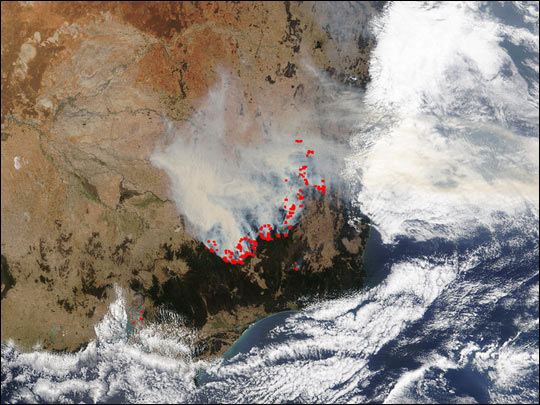Location Australia Buildingsdestroyed 41 houses | Burned area 21,241,000 ha Injuries Unknown | |
 | ||
Date(s) Winter 2002 – Spring 2003 Cause Various, predominantly lightning | ||
The 2002–03 Australian bushfire season was a particularly extensive bushfire season in Australia. It ran predominantly from December 2002 to March 2003 and involved over 3,000 separate fires in Victoria alone. The 2003 Canberra bushfires were also particularly severe.
Contents
The developing drought in Australia and well below-average rainfall through winter and spring of 2002 established conditions conducive to above-average bushfire potential. During the 2002–03 season, there were 5,999 bushfires attended by the relevant agency Australia-wide and 7 fatalities, 4 of those from the January Canberra fires.
Perhaps the most well known fire of the season was the Eastern Victorian alpine bushfires that burnt in north-eastern Victoria, the Victorian Alps and Gippsland. This fire was ignited in several locations by multiple lightning strikes and burnt 1.12 million hectares of land over the course of 2 months. Over 15,000 personnel were directly engaged with this fire complex.
Overview
While hundreds or thousands of individual fires burn in any given bushfire season, areas of large fires that join and split are referred to as 'fire complexes'. The major fire complexes included:
September–November 2002
The first fires of the 2002–03 season were reported in September 2002 in Victoria. Ongoing drought and lack of spring rain led to the Bureau of Meteorology predicting conditions comparable to that of the 1983 Ash Wednesday fires, and Fire Authorities were subsequently placed on high alert.
December 2002
On 17 December, multiple lightning strikes in the Big Desert Wilderness Park ignited vegetation, creating a fire complex within the park south of Murrayville and burning until 25 December. The Big Desert Fire was, at the time, the biggest fire in Victoria in 20 years, affecting 181,400 hectares of predominantly public land and requiring significant resources to contain.
January–March 2003
On 6 January, lightning ignited a fire near Yambulla, north west of Genoa in East Gippsland. The fire was seen as posing a major threat, requiring significant firefighting resources. At the time the main fires started on 8 January, a total of 180 DSE firefighters were allocated to the Yambulla fire, supported by bulldozers and firebombing aircraft. The fire was contained within a few days. This level of resourcing did, however, decrease the local resources available to fight the multiple outbreaks that followed.
On 7 January, multiple lightning strikes in north-east Victoria and Gippsland started hundreds of fires in Victoria that would remain uncontained until 7 March, a full 2 months later. In early February, at the peak of the fires, around 3,760 people were involved in the fire effort, excluding local CFA brigades. This figure includes 160 Defence Force staff, over 300 interstate firefighters, 33 alpine firefighting specialists from New Zealand, and 35 personnel from the United States. In total, 15,725 personnel were directly engaged on the Eastern Victorian alpine bushfires.
Aftermath
In October 2003, the DSE published a report on the 2002–03 fires, which was considered a formidable task as it had to document over 3,000 separate fires and all the effects and personnel involved. The report concluded that the responses and containment of the fires was commendable. No lives were lost, and stock losses and property damage was kept to a minimum considering the area of land affected by the fires.
